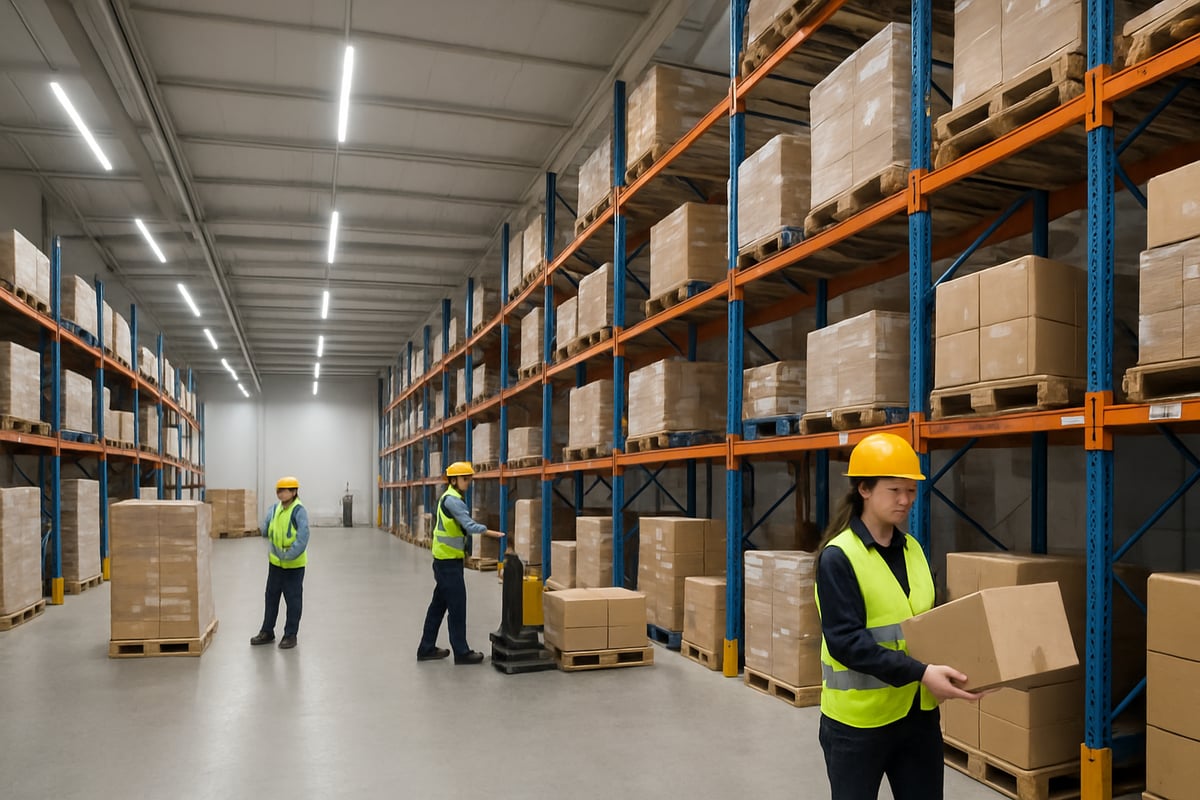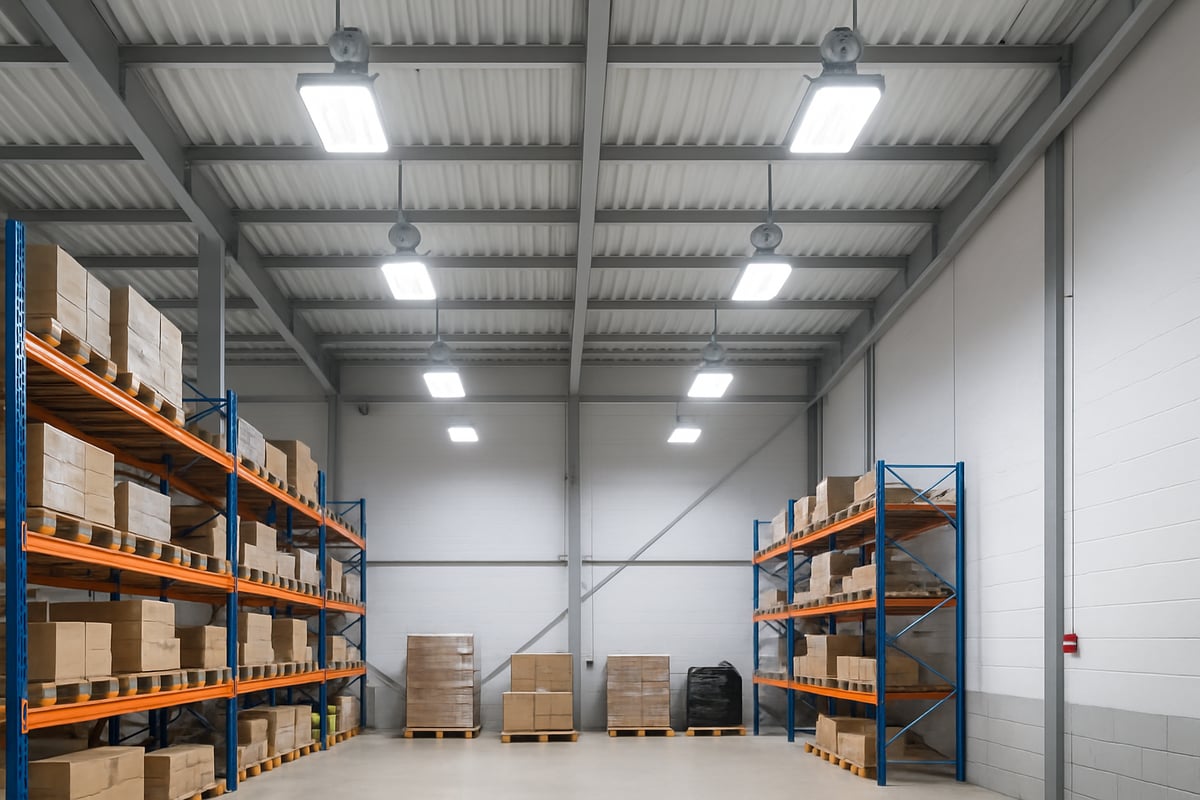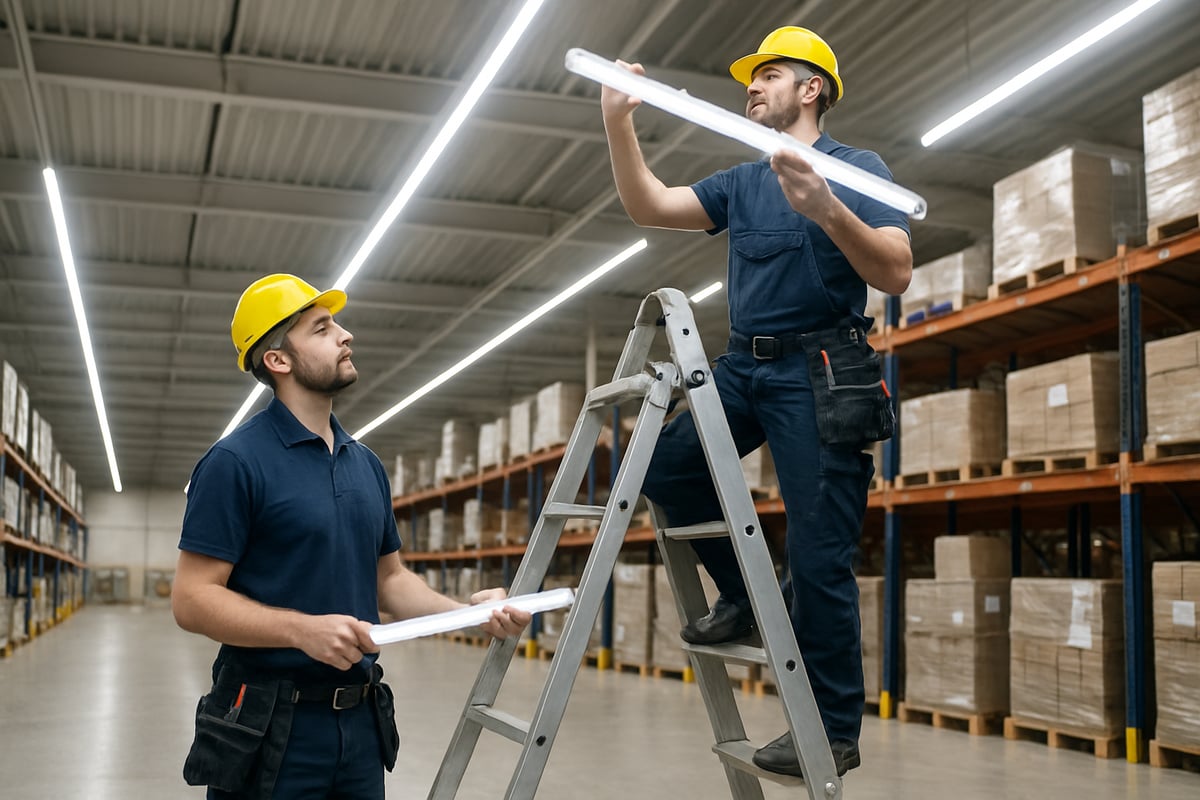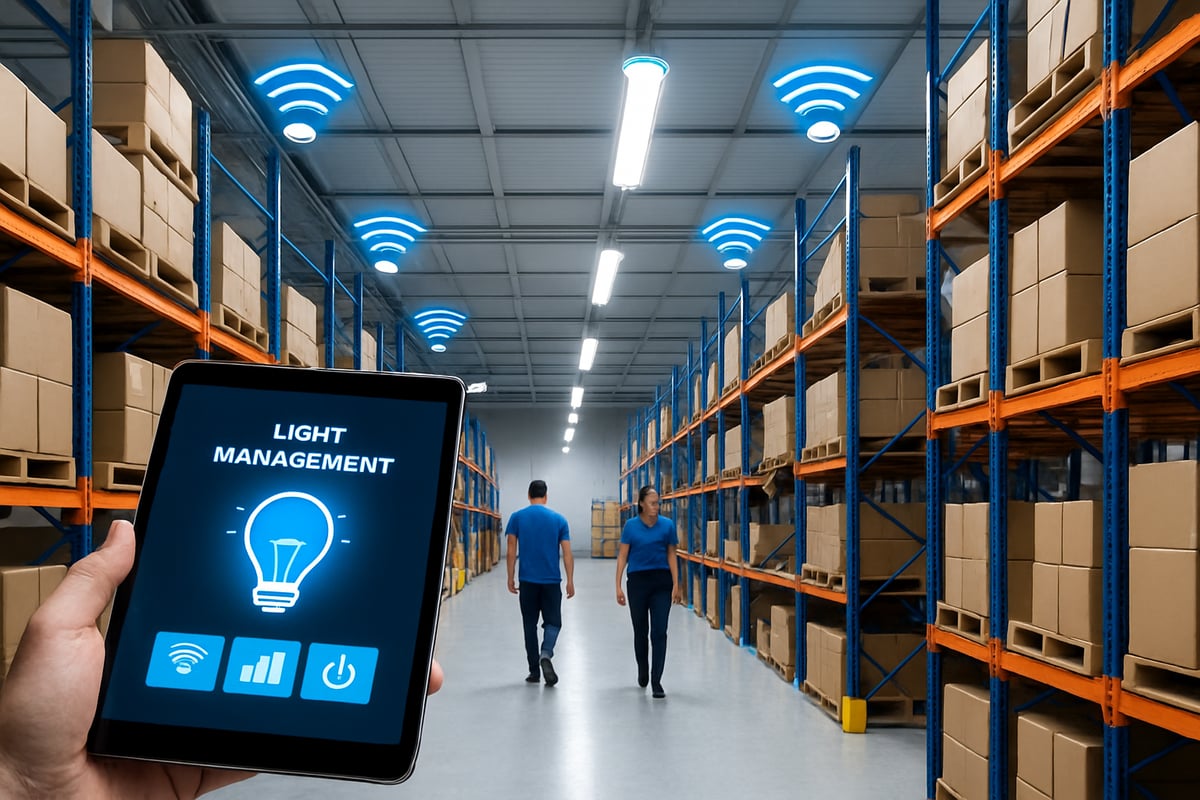Energy costs are rising and stricter regulations are forcing companies to take a critical look at their lighting. Modern warehouses in 2025 demand solutions that are not only energy efficient, but also contribute to safety and efficiency.
This ultimate guide on LED lighting for warehouse helps business owners make the right choices. You will discover the latest trends, benefits, technical requirements, smart systems and sustainable applications.
Are you ready to save money, increase work comfort and future-proof your warehouse? Read on and discover practical tips and advice you can start using right away.
Why switch to LED lighting in the warehouse?
Rising energy costs and stricter regulations require smart choices. More and more companies are therefore choosing LED lighting for warehouse. This switch not only offers direct savings, but also ensures a safer, more sustainable and future-proof working environment.

Energy and cost savings
Switching to LED lighting for warehouse provides energy savings averaging 65 to 90 percent over traditional lighting. This means an immediate reduction in energy bills and quick return on investment. LED fixtures also produce significantly less heat, reducing the cooling load in the warehouse.
In addition to cost savings, there are additional benefits such as reduced maintenance and longer lamp life. This structurally reduces operational costs. It is clear that with LED lighting for warehouse, companies can structurally reduce their energy bills. Read more about the benefits of LED warehouse lighting for a complete overview of savings and practical experiences.
Safety and productivity
Good lighting is essential for workplace safety. LED lighting for warehouse provides bright, even light distribution, making obstacles and hazards immediately visible. This reduces the risk of accidents and increases employee concentration while working.
In addition, LED lighting for warehouse has less flicker and offers a pleasant light color. This reduces fatigue and health issues when working for long periods of time. A comfortable and safe work environment automatically leads to higher productivity and fewer mistakes.
Environment and sustainability
With LED lighting for warehouse, durability and environmental friendliness are key. LED lamps contain no harmful substances such as mercury and last up to 100,000 hours. This reduces waste and minimizes replacements.
The lower energy consumption results in a significant CO2 reduction. So by choosing LED lighting for warehouse, a company contributes to achieving its sustainability goals. After all, less energy means fewer emissions and a smaller carbon footprint.
Future-proofing and regulation
Requirements for energy efficiency and sustainability are becoming increasingly stringent. With LED lighting for warehouse, you respond directly to existing and future laws and regulations. Governments encourage energy-saving measures and set ever higher requirements for company lighting.
By investing in LED lighting for warehouse now, you will be prepared for future obligations and avoid unexpected adjustment costs. This will keep the warehouse not only efficient, but also compliant and future-proof.
Case study
The Rijksmuseum recently made a successful switch: "Our existing luminaires were carefully converted to energy-efficient LED. This preserved the original light lines and avoided waste." This practical example proves that LED lighting for warehouse not only provides savings, but can also be applied in a circular and responsible way.
So choosing LED lighting for warehouse is an investment in safety, sustainability and cost control, with proven results in practice.
Main technical requirements for LED warehouse lighting in 2025
Choosing the right LED lighting for warehouse requires attention to technical details. In 2025, the requirements will become stricter and it is crucial to invest in systems that meet the latest standards. This way you not only ensure energy efficiency, but also safety, comfort and future-proofing. If, as a company, you want to be prepared for the future, LED lighting for warehouse must meet a number of important technical specifications.

Brightness and standards
For led lighting for warehouse, the brightness must be tailored to the work and the applicable guidelines. According to the NEN standard, a minimum of 500 lux is required at workstations, which ensures adequate visibility and safety. In addition, an efficiency of at least 110 lumens per watt is necessary to meet energy targets.
Those who want to go deeper into European directives and lux values will find practical details in the NEN-EN 12464-1 guidelines for indoor lighting. By adhering to these standards, LED lighting for warehouse becomes a reliable foundation for any logistics operation.
Light quality and color
The color rendering index (CRI) of LED lighting for warehouse should be at least 80. This ensures true-to-life colors, which is important for recognizing labels and products. For light color, 4000K is recommended, as neutral white light increases alertness and reduces fatigue. Good light quality makes LED lighting for warehouse not only more pleasant, but also more functional for daily use.
Uniformity and comfort
Uniformity is essential to avoid shadows and dark corners. Led lighting for warehouse should have an SDCM value below 3 so that color differences between fixtures are minimal. It is also important that flicker (light flicker) is lower than 15%. This prevents fatigue and health issues in employees who often work under artificial light for long periods of time. Thus, LED lighting for warehouse contributes to comfort and well-being.
Robustness and protection
In a warehouse environment, LED lighting for warehouse is often exposed to dust, moisture and impacts. Therefore, choose fixtures with at least IP54 protection so that they can withstand these influences. In production or logistics areas where extra robustness is needed, IK09 or even IK10 shock resistance is recommended. This will keep the LED lighting for warehouse functional and safe, even under harsh conditions.
Modular construction and replaceability
Durable LED lighting for warehouse is modular. Each component, from driver to LED module, should be easily replaceable. This makes maintenance faster and cheaper, while extending the life of the overall system. A modular system also means that upgrades are easy to make in the future, keeping LED lighting for warehouse always up-to-date and having a low total cost of ownership.
Smart sensors and lighting management
The latest generation of LED lighting for warehouse integrates smart sensors for presence and daylight detection. This automatically controls lighting based on activity and natural light. Light management systems provide automatic dimming and shutdown, providing additional energy savings. This smart approach increases the efficiency of LED lighting for warehouse and contributes to flexibility and ease of use.
Case example
Plantion Ede has successfully made the switch to LED lighting for warehouse: "The areas are much better lit which has a positive effect on our employees and on the presentation of the flowers and plants." This example shows that investing in high-quality led lighting for warehouse directly contributes to a pleasant and safe working environment, while reducing energy consumption.
Roadmap: this is how to implement LED lighting in your warehouse
Successfully implementing LED lighting for warehouse requires a structured approach. With the right roadmap, you'll realize maximum energy savings, increase safety and be prepared for the future. Below you will find a clear roadmap that guarantees you will achieve the best results in 2025.

1. Analysis of the current situation
Start with a thorough inventory of your existing lighting. Record how many fixtures there are, what types are hanging, and how heavily the various zones of the warehouse are used. Create a current floor plan and determine the desired light levels for each zone.
Pay attention to specific areas of concern such as workstations, storage areas, loading and unloading areas and passages. This analysis will give you insight into the optimal design for led lighting for warehouse and allow you to make more targeted choices.
2. Lighting plan and calculation
Have a professional lighting plan drawn up that meets the NEN standards for warehouse lighting. A lighting plan will help you determine how many fixtures you need, where best to place them and what brightness is required per zone.
With lighting calculations, avoid blind spots or overexposure. Orient yourself to options through vendors who specialize in LED lighting for businesses, so you can be sure that the design fits the requirements of your warehouse.
3. Choice: retrofit or new system?
Consider whether you can convert existing fixtures (retrofit) or whether a new light line system is needed. Retrofit is often cost-effective if the current infrastructure is still adequate and compatible with LED lighting for warehouse.
A new system offers maximum flexibility, higher energy performance and is better prepared for future expansion or integration with smart technologies. Consider total service life and maintenance costs when making your choice.
4. Selection of fixtures and sensors.
Choose certified and quality LED fixtures specifically designed for warehouse environments. Look for labels, long warranty periods and proven longevity. Add smart sensors that detect motion and daylight, so LED lighting for warehouse is on only when needed.
Check that the fixtures chosen are modular so that components can be easily replaced in case of failure or upgrade.
5. Installation and commissioning
Have the installation performed by certified technicians, preferably with VCA certification. During commissioning, the light management system is tested and tuned to the actual situation in the warehouse.
Make sure all fixtures are correctly positioned for optimal light distribution and that the system functions safely. This way, you will get the most out of your investment in LED lighting for warehouse.
6. Monitoring and maintenance
Implement a system for monitoring and maintenance. Use cloud or building management systems to track the performance of LED lighting for warehouse. Schedule periodic checks so that defects or performance deviations are noticed in a timely manner.
Regular maintenance and monitoring extend the life of the system and ensure consistently high light levels.
Practical Tip
Use existing light line rails and cabling whenever possible. This saves costs, speeds installation and contributes to a circular and sustainable approach to LED lighting for warehouse. Consider the checklist below in your approach:
- Control of existing infrastructure
- Having a professional lighting plan created
- Choosing certified fixtures
- Installation by professionals
- Securing monitoring and maintenance
With this roadmap, you lay the foundation for a future-proof and energy-efficient warehouse.
The role of smart lighting and light management systems
Smart lighting and light management systems are indispensable in LED lighting for warehouse in 2025. They are the heart of an efficient, safe and sustainable warehouse. By cleverly integrating these systems, you maximize energy savings and ensure optimal working conditions. But what exactly does lighting management entail, and why is it so important for modern warehouses?

What is light management?
Lighting management refers to the central control and automation of LED lighting for warehouse through intelligent systems such as DALI or Encelium. These systems allow lighting to be adjusted by zone, time of day or activity. Linking with building management systems, such as BACnet, creates a truly smart warehouse.
Light management allows you to monitor and adjust everything: from light intensity to energy consumption. This contributes to lower energy costs and a longer life of your installation. By combining sensors, software and smart fixtures, LED lighting for warehouse is fully optimized.
Benefits of smart systems
The benefits of smart LED lighting systems for warehouse are significant. Automatic dimming and shutdown provide up to 90% energy savings, especially when rooms are temporarily unused. Fewer switching moments extend fixture life. Constant Light Output (CLO) technology keeps the light level constant without loss of quality.
Smart systems offer flexibility: you can manage zones separately and respond immediately to changing needs. For those interested in learning more about the latest technologies and implementations, we offer Smart LED lighting systems An overview of opportunities and practical applications.
| Advantage | Explanation |
|---|---|
| Energy Efficiency | Up to 90% savings, less waste |
| Flexibility | Zones and times separately adjustable |
| Sustainability | Less maintenance, longer service life |
Safety and comfort
Safety and comfort are crucial with LED lighting for warehouse. Smart systems automatically adjust light based on presence and daylight. This keeps the working environment optimal at all times, without glare or dark corners.
Individual zones can be tailored to employees' needs. Less flicker and the right light color reduce fatigue and increase concentration. This not only increases safety, but also productivity.
Data and optimization
With modern LED lighting management systems for warehouse lighting, you always have insight into current energy consumption and lighting performance. Data is stored in the cloud, allowing you to quickly analyze and optimize.
Based on these insights, you can make immediate adjustments for additional savings. Think about adjusting schedules, discovering inefficient areas or planning maintenance. This keeps the warehouse always up-to-date and cost-effective.
Case example
A great practical example of LED lighting for warehouse with light management comes from MTU Rolls Royce. Here, a lighting renovation with smart techniques led to maximum energy savings. Employees now experience brighter light, more comfort and a safer feeling in the workplace.
By using smart lighting and a thoughtful lighting management system, the company benefited from reduced energy consumption as well as an improved working environment. This underscores the importance of investing in the right technology for any modern warehouse.
Sustainability and social impact: circular and responsible choices
Sustainability is indispensable in LED lighting for warehouse in 2025. Companies are not only looking for energy savings, but also want to contribute to a circular economy and social impact. With led lighting for warehouse, how do you make the best choices for environment, society and future?
Circular lighting
Circular lighting focuses on reusing existing fixtures. This means that when switching to LED warehouse lighting, you don't have to replace everything. Old light lines can often be converted to modern, energy-efficient systems. This avoids unnecessary waste and saves costs.
In addition, it is important to recycle old components in an environmentally friendly way. This way, the environmental impact remains minimal. Want to learn more about circular applications and smart solutions? Then visit the page about industrial lighting solutions for practical examples and advice.
Social return on investment (SROI).
Social impact is increasingly important in led lighting for warehouse. By cooperating with social workshops, people distanced from the labor market are given new opportunities. For example, they can be used in the installation or renovation of lighting systems.
This not only creates additional employment opportunities, but also contributes to inclusiveness within the sector. Companies thus demonstrate social responsibility and give concrete substance to their SROI objectives. Thus, LED lighting for warehouse becomes part of a broader sustainability policy.
Certifications and seals of approval
When choosing LED lighting for warehouse, certifications play a big role. Consider, for example, PSO Step 3, which proves you are among the top 10% socially entrepreneurial companies.
Meeting current sustainability and CSR requirements is essential to the future-proofing of your business. In addition, reports and labels are increasingly being asked for in tenders. Want to know more about regulations? Then read about legislation LED lighting companies for current information.
Case study
DSM Zwolle shows how led lighting for warehouse brings together sustainability and corporate social responsibility. The company deliberately chose to reuse existing infrastructure and engaged social workshops for the implementation.
The result is not only lower energy consumption, but also a positive contribution to the local community. This real-life example underscores that smart choices around LED warehouse lighting have a direct impact on people and the environment.
Impact on CO2 reduction
One of the biggest advantages of LED lighting for warehouse is the substantial reduction of CO2 emissions. Low energy consumption significantly reduces the carbon footprint of companies.
In many cases, up to 90% can consume less energy compared to conventional systems. This is in line with climate goals and contributes to greener operations. Thus, LED lighting for warehouse becomes a powerful tool for sustainability.
Transparency and reporting
Transparency is important when documenting the results of LED lighting for warehouse. More and more companies are opting for detailed reports on energy and environmental savings.
This data is valuable for annual reports, CSR audits and external communications. By reporting structurally, you make the impact of sustainable choices transparent and verifiable.
Common mistakes and practical tips for successful LED implementation
Switching to LED lighting for warehouse seems easy, but in practice, mistakes are regularly made that negatively affect efficiency and comfort. Many companies choose a standard solution too quickly, which means that the benefits of LED lighting for warehouse are not fully utilized.
Errors in switching to LED
A common problem is choosing the wrong brightness or color temperature. This leads to too bright or too dim light, which does not improve productivity and safety. In addition, people often forget to take into account the distribution and spacing of fixtures, causing shadows at workstations.
It also underestimates the importance of maintenance and replaceability. If you don't choose modular luminaires, defects can cause high costs later on. Finally, we see companies overlooking smart sensors or light management systems, which means the maximum energy-saving potential of LED lighting for warehouse is not realized.
Tips for success
Want to get the most out of led lighting for warehouse? Always have a professional lighting plan made by a specialist. This way you can be sure that the lighting meets the required standards and is optimally matched to your warehouse layout. Choose fixtures with proven longevity and a warranty of at least five to ten years.
When selecting, pay attention to certifications and labels to ensure quality and durability. Involve employees in the transition to LED lighting for warehouse for support and ease of use. More practical tips can be found in this comprehensive overview: Tips for lighting your warehouse.
Practice
Successful projects show the importance of a thoughtful approach. Wageningen University, for example, installed 1300 LED lights, resulting in minimal inconvenience and maximum savings. At Houtgroep Van Drimmelen, more than 700 meters of light lines were renewed, leading to a noticeable improvement in lighting and significant energy savings.
These examples illustrate that investing in led lighting for warehouse not only reduces energy costs, but also improves the working environment and increases safety.
Advice and support
Take advantage of free lighting analysis and professional advice when implementing LED lighting for warehouse. Always choose suppliers with extensive experience in industrial projects and smart systems. They can guide you from design to installation and maintenance, ensuring that your investment is future-proof.
By working with experts, you avoid common mistakes and benefit from the latest technologies in LED lighting for warehouse.
Overview: checklist for LED warehouse lighting in 2025
- Does the light intensity meet NEN standards (at least 500 lux)?
- Is the color temperature (around 4000K) appropriate for the work?
- Are fixtures evenly spaced for optimal dispersion?
- Were modular, easily replaceable components chosen?
- Are smart sensors and lighting management applied?
- Do the fixtures have relevant certifications and labels?
- Has sustainable maintenance and recycling been taken into account?
- Are all current lighting standards and regulations?
With this checklist, you can be sure of a successful transition to led lighting for warehouse, with an eye on energy, comfort and future-proofing.
You now have insight into the latest trends, requirements and smart possibilities of LED lighting for warehouses in 2025. Maybe you're wondering which solution best suits your situation or how to achieve maximum savings and comfort with a tailored sustainable project. We are happy to help you with clear advice and a practical approach, tailored to your business and goals. Would you like to discuss the best LED solution for your warehouse?
Schedule a consultation
Thus, together we take the next step toward a more efficient, safer and future-proof warehouse.

